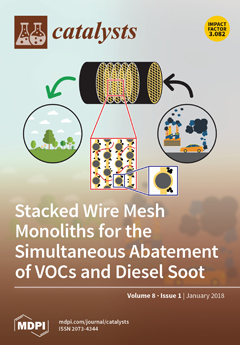Alumina-supported silver and indium catalysts are investigated for the hydrogen-assisted selective catalytic reduction (SCR) of NO
x with ammonia. Particularly, we focus on the active phase of the catalyst and the formation of surface species, as a function of the gas environment. Diffuse
[...] Read more.
Alumina-supported silver and indium catalysts are investigated for the hydrogen-assisted selective catalytic reduction (SCR) of NO
x with ammonia. Particularly, we focus on the active phase of the catalyst and the formation of surface species, as a function of the gas environment. Diffuse reflectance ultraviolet-visible (UV-vis) spectroscopy was used to follow the oxidation state of the silver and indium phases, and in situ diffuse reflectance infrared Fourier transform spectroscopy (DRIFTS) was used to elucidate the formation of surface species during SCR conditions. In addition, the NO
x reduction efficiency of the materials was evaluated using H
2-assisted NH
3-SCR. The DRIFTS results show that the Ag/Al
2O
3 sample forms NO-containing surface species during SCR conditions to a higher extent compared to the In/Al
2O
3 sample. The silver sample also appears to be more reduced by H
2 than the indium sample, as revealed by UV-vis spectroscopic experiments. Addition of H
2, however, may promote the formation of highly dispersed In
2O
3 clusters, which previously have been suggested to be important for the SCR reaction. The affinity to adsorb NH
3 is confirmed by both temperature programmed desorption (NH
3-TPD) and in situ DRIFTS to be higher for the In/Al
2O
3 sample compared to Ag/Al
2O
3. The strong adsorption of NH
3 may inhibit (self-poison) the NH
3 activation, thereby hindering further reaction over this catalyst, which is also shown by the lower SCR activity compared to Ag/Al
2O
3.
Full article





